|
|
|
Sort Order |
|
|
|
Items / Page
|
|
|
|
|
|
|
| Srl | Item |
| 1 |
ID:
080346
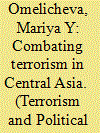

|
|
|
|
|
| Publication |
2007.
|
| Summary/Abstract |
This work examines differences in the level of violence of counterterrorism measures adopted by Central Asian states. Why do some Central Asian governments opt for wanton repression in the name of the struggle with terrorism, while others adopt less severe methods of control and prevention? To answer this question, this study draws on a synthesis of rationalist and constructivist explanations. Like rationalists, it posits that the magnitude of terrorism and states' material capabilities affect governments' responses to terrorism. Following constructivists, the study stresses the impact of ideas about the nature of terrorist threats and views on the appropriateness of the use of force on the counterterrorism policies of Central Asian states.
|
|
|
|
|
|
|
|
|
|
|
|
|
|
|
|
| 2 |
ID:
080344
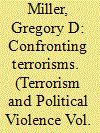

|
|
|
|
|
| Publication |
2007.
|
| Summary/Abstract |
Much of the recent debate among policymakers and in recent scholarship focuses on how states should respond to terrorism: whether they should use harsh policies to punish terrorists and thus deter future acts, or concentrate on root causes and reduce incentives to use terrorism. Often ignored in this discussion are the characteristics that distinguish terrorist groups from one another, and that influence the effectiveness of a state's actions. This article examines group motivation - national-separatism, revolution, reaction, or religion - as one key trait, and finds that these different "terrorisms" do affect the relative success of various counterterrorist policies
|
|
|
|
|
|
|
|
|
|
|
|
|
|
|
|
| 3 |
ID:
080342
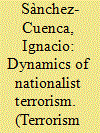

|
|
|
|
|
| Publication |
2007.
|
| Summary/Abstract |
Nationalist terrorism aspires to independence or greater autonomy for some territory. The combination of territorial claims and armed struggle gives rise to a very definite strategy, violence intended to coerce the State. Nationalist terrorist organizations kill repeatedly with the aim of breaking the will of the State. They engage in a peculiar sort of war of attrition with the State. This paper analyzes comparatively the war of attrition strategy in two organizations, ETA and the IRA. The focus of the paper is on strategy: it examines how ETA and the IRA understood their activity in terms of war of attrition and how they developed their strategy subject to some constraints, such as the moderate preferences of their supporters. I show that popularity constraints account for the high degree of selectivity in their killings. The analysis is based on a combination of historical information, internal documents, and a large data set I have constructed of the killings of these two organizations.
|
|
|
|
|
|
|
|
|
|
|
|
|
|
|
|
| 4 |
ID:
080347
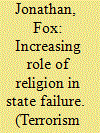

|
|
|
|
|
| Publication |
2007.
|
| Summary/Abstract |
This study examines the extent of religious conflict between 1960 and 2004 in the context of all domestic conflicts in that era based on data from the State Failure dataset. The findings show that until 2002 religious conflicts were a minority of all conflicts, but from 2002 to 2004 they were a majority of all conflicts. This study also examines the extent to which groups belonging to different religious traditions (i.e., Christianity, Islam, etc.) participate in conflict. The specific results on the relative participation in conflict by Christian and Muslim groups depend on the method used to measure conflict. However, no matter how conflict is measured, the results consistently show a rise in Islamic participation in conflict since the late 1970s. Also, for nearly the entire period covered by this study, the majority of religious conflicts involved Muslims. All of this supports contentions that rather than causing religion's demise, modernity has caused a resurgence of religion.
|
|
|
|
|
|
|
|
|
|
|
|
|
|
|
|
| 5 |
ID:
080345
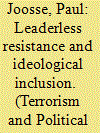

|
|
|
|
|
| Publication |
2007.
|
| Summary/Abstract |
Leaderless resistance is a strategy of opposition that allows for and encourages individuals or small cells to engage in acts of political violence entirely independent of any hierarchy of leadership or network of support. This article examines the development of the leaderless resistance strategy by the radical right and more recently by the radical environmentalist movement. While both movements use leaderless resistance to avoid detection, infiltration, and prosecution by the state, environmental groups like the Earth Liberation Front (ELF) benefit additionally because of the ideological inclusiveness that leaderless resistance fosters. Historically, ideological cleavages have rendered radical environmental groups such as Earth First! less effective than they would have been otherwise. Using leaderless resistance, however, the ELF eliminates all ideology extraneous to the specific cause of halting the degradation of nature. This elimination enables the ELF to mobilize a greater number of "direct actions
|
|
|
|
|
|
|
|
|
|
|
|
|
|
|
|
| 6 |
ID:
080343
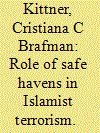

|
|
|
|
|
| Publication |
2007.
|
| Summary/Abstract |
This article will develop an explanatory theory on terrorist safe havens. Focusing on Islamist Terrorist networks, this article argues that four specific conditions are necessary for the establishment of a safe haven for Islamist terrorist networks: geographic features, weak governance, history of corruption and violence, and poverty. At the conclusion of the article, the developed theory is applied to the Tri-Border Area of South America (TBA), where the frontiers of Argentina, Brazil, and Paraguay meet, an area overlooked by the 9/11 National Commission Report's list of Islamist terrorists' safe havens.
|
|
|
|
|
|
|
|
|
|
|
|
|
|
|
|
|
|
|
|
|